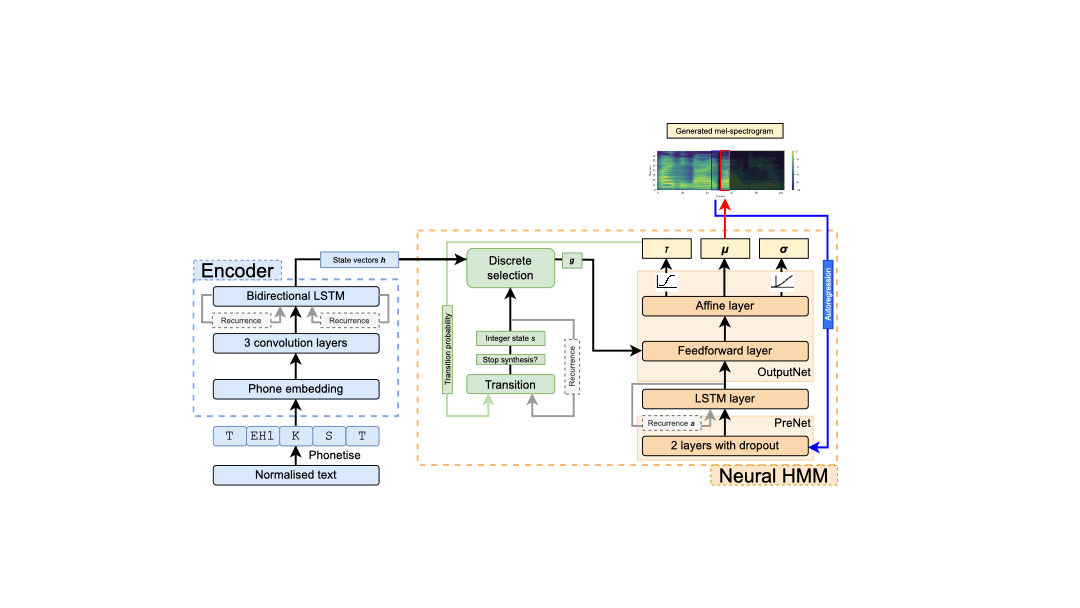This is the official code repository for the paper "Neural HMMs are all you need (for high-quality attention-free TTS)". For audio examples, visit our demo page. pre-trained model (female) and pre-trained model (male) are also available.
- Download and extract the LJ Speech dataset. Place it in the
datafolder such that the directory becomesdata/LJSpeech-1.1. Otherwise update the filelists indata/filelistsaccordingly. - Clone this repository
git clone https://github.com/shivammehta25/Neural-HMM.git- If using single GPU checkout the branch
gradient_checkpointingit will help to fit bigger batch size during training. - Use
git clone --single-branch -b gradient_checkpointing https://github.com/shivammehta25/Neural-HMM.gitfor that.
- If using single GPU checkout the branch
- Initalise the submodules
git submodule init; git submodule update - Make sure you have docker installed and running.
- It is recommended to use Docker (it manages the CUDA runtime libraries and Python dependencies itself specified in Dockerfile)
- Alternatively, If you do not intend to use Docker, you can use pip to install the dependencies using
pip install -r requirements.txt
- Run
bash start.shand it will install all the dependencies and run the container. - Check
src/hparams.pyfor hyperparameters and set GPUs.- For multi-GPU training, set GPUs to
[0, 1 ..] - For CPU training (not recommended), set GPUs to an empty list
[] - Check the location of transcriptions
- For multi-GPU training, set GPUs to
- Once your filelists and hparams are updated run
python generate_data_properties.pyto generatedata_parameters.ptfor your dataset (the defaultdata_parameters.ptis available for LJSpeech in the repository). - Run
python train.pyto train the model.- Checkpoints will be saved in the
hparams.checkpoint_dir. - Tensorboard logs will be saved in the
hparams.tensorboard_log_dir.
- Checkpoints will be saved in the
- To resume training, run
python train.py -c <CHECKPOINT_PATH>
- Download our pre-trained LJ Speech model.
(This is the exact same model as system NH2 in the paper, but with training continued until reaching 200k updates total.)
- Alternatively, you can also use a pre-trained RyanSpeech model (trained for 150k updates).
- Download HiFi gan pretrained HiFiGAN model.
- We recommend using fine tuned on Tacotron2 if you cannot finetune on NeuralHMM.
- Run jupyter notebook and open
synthesis.ipynb.
- In
src.hparams.pychangehparams.precisionto16for mixed precision and32for full precision.
- Since the code uses PyTorch Lightning, providing more than one element in the list of GPUs will enable multi-GPU training. So change
hparams.gpusto[0, 1, 2]for multi-GPU training and single element[0]for single-GPU training.
- If you encounter this error message
[W pthreadpool-cpp.cc:90] Warning: Leaking Caffe2 thread-pool after fork. (function pthreadpool), this is a known issue in PyTorch Dataloader. - It will be fixed when PyTorch releases a new Docker container image with updated version of Torch. If you are not using docker this can be removed with
torch > 1.9.1
- If you encoder this error message
ImportError: cannot import name 'get_num_classes' from 'torchmetrics.utilities.data' (/opt/conda/lib/python3.8/site-packages/torchmetrics/utilities/data.py) - Update the requirement.txt file with these requirements:
torch==1.11.0a0+b6df043
--extra-index-url https://download.pytorch.org/whl/cu113
torchmetrics==0.6.0If you have any questions or comments, please open an issue on our GitHub repository.
If you use or build on our method or code for your research, please cite our paper:
@inproceedings{mehta2022neural,
title={Neural {HMM}s are all you need (for high-quality attention-free {TTS})},
author={Mehta, Shivam and Sz{\'e}kely, {\'E}va and Beskow, Jonas and Henter, Gustav Eje},
booktitle={Proc. ICASSP},
year={2022}
}
The code implementation is based on Nvidia's implementation of Tacotron 2 and uses PyTorch Lightning for boilerplate-free code.
